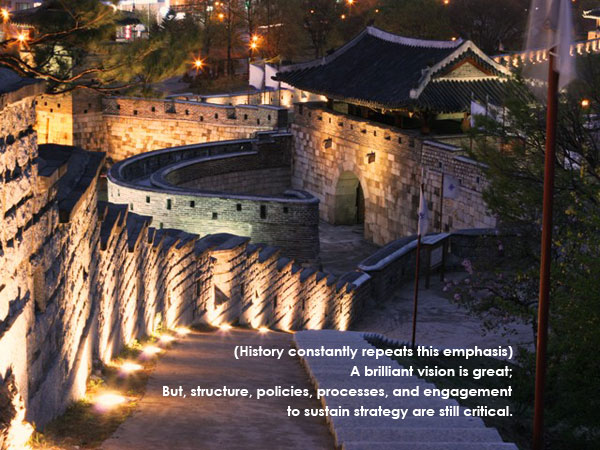Transforming the Promise of a Vision into Practice by Managing Change
“Historical consciousness has a fullness of paradox that future imagination cannot match.”
David Brooks (2014, March 20. Going home again. New York Times). Brooks is an American conservative political and cultural commentator who writes for The New York Times.

Image by Edwin Lee
In 334 B.C., Alexander the Great began his world conquest. He broke the Persian Empire and continued his advance until he reached the Indus River. But his empire began to crumble the moment breath left his body, leaving only scattered fragments for his heirs to rule.
Fast forward a century some 3,500 miles to the east, Emperor Qin Shi Huang completed the annexation of his neighbors, yet the boundaries of his middle kingdom were extended in the dynasties following his demise. Two leaders, with similar visions achieved through military brilliance, but whose legacy was the most enduring? And why?
Today’s business world is awash with leaders’ visions for the future. Yet, so many fail to realize their dreams. A key factor in the collapse of Alexander’s empire was his impatience with the details of managing people and the bureaucracy necessary to hold a nation together. Similarly today, many executives have limited patience with the depth and quantity of communication and engagement required to shift their organizations. They are easily distracted by their next project conquest.
Qin Shi Huang, however, understood what was required for sustainability. He put processes and procedures in place to stabilize his conquests. Two in particular stood out – he standardized the written language (the basis of communications), and the currency (the unit of finances). The people of his enormous land could then communicate with each other and exchange goods with an ease that rivals today.
We live in different times than Alexander and Qin Shi Huang, but the need for structure and process to sustain strategy is still critical. A brilliant vision is great, but it’s critical to tether that direction to the people who need to execute and sustain it. As a vision becomes tangible through projects, embedding the principles and the discipline of change management into the project structure will help identify and mitigate risks, provide a platform for a more effective communication and engagement, and support the people most impacted by the changes.
Actions to take when integrating change management into project work
As project manager or team leader, consider the following when integrating change management within project streams or processes:
- How do the details of your project impact other roles in the organization? Many processes are developed on paper outside the environment where it will be executed. Assessing the impact of the changes on the organizational roles before implementation will help surface the communication and training requirements early.
- Have you assessed your team’s readiness for the change? Plan on assessing the readiness for change at the beginning, post-initiation, and pre-implementation stages. This should be considered a trending evaluation, revisited at critical times in the process. If readiness scores are particularly low at the pre-initiation phase, additional assessments may be built into the process. Low readiness significantly impacts the drive for sustainability.
- Have you built and structured communication and feedback mechanisms into the project plan? Integrating communication and feedback into project plans means that these elements will be visible and trackable as the project progresses. Regularly ensure employees and key stakeholders get the information they need to accept and implement the change in their work. Responding to the feedback from the people impacted by the change can be critical to the overall success of the project.
As change leaders and agents, we build support and commitment by demonstrating how integrating project management and change management practices can deliver results. To achieve this, we need to:
- Understand the organization’s project management process. While basic principles remain the same, each organization adapts project management methodologies to suit their needs. Thorough understanding of your corporate project management methodology allows you to utilize established systems and/or to identify potential roadblocks that you should mitigate.
- Understand the work climate of the project management team. In many cases, project teams are made up of a combination of employees and consultants, frequently from multiple firms. As a change agent, invest the time to determine how things get decided and done on the project team.
- Look for quick wins to demonstrate how the change(s) helps all those involved be successful. Engage leaders and let them know how change management is helping their vision become a reality. Outline to your subordinates where there is added-value to their work. And don’t forget to communicate, communicate, communicate.
- Transforming the Promise of a Vision into Practice by Managing Change - June 24, 2014
- (A Journey of) Transforming Stumbling Blocks to Stepping Stones - January 14, 2014





